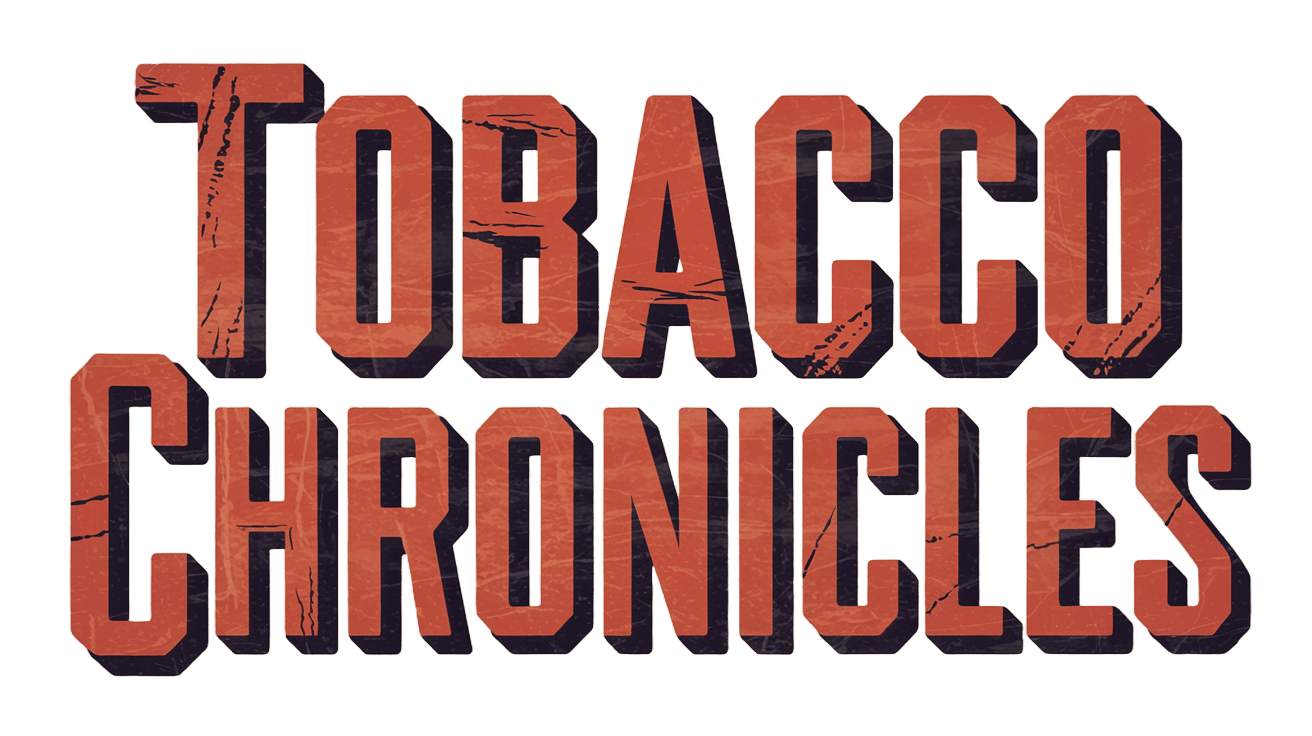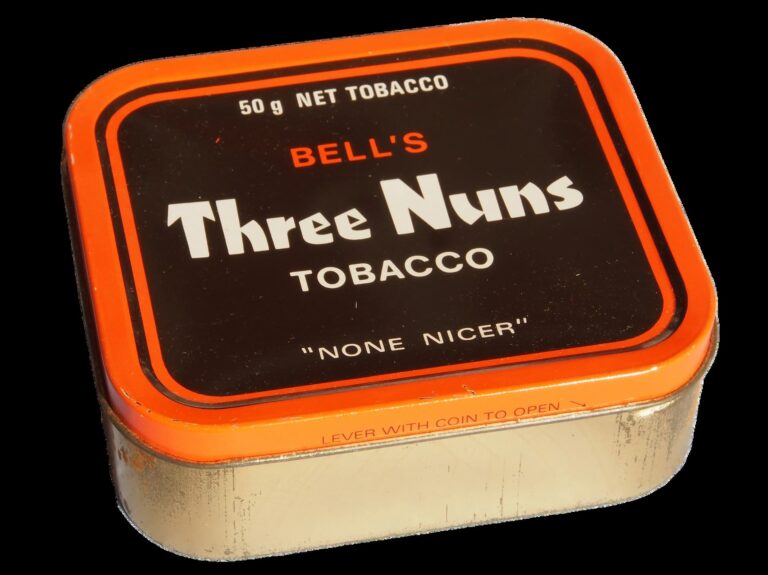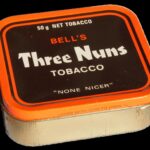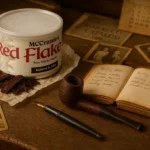There are certain moments in a pipe smoker’s journey that feel like archaeological discoveries, and opening this aged tin of Elephant & Castle The Stout is undoubtedly one of them. As I carefully pry off the lid of this 1986 vintage tin that has been quietly aging in my cellar for nearly four decades, I’m struck by the profound rarity of what I’m about to experience. This isn’t just any tobacco—this is a piece of pipe smoking history from one of the most innovative and short-lived tobacco lines ever created. The Elephant & Castle brand, conceived by the visionary Siegel brothers and manufactured by the legendary C.E. McConnell in London, existed for only eight years in the 1980s, yet it left an indelible mark on the pipe tobacco world. The Stout, with its revolutionary Oriental-Virginia composition, represented everything that made this line special: innovation, quality, and an uncompromising commitment to creating something truly unique. Tonight, as I prepare to smoke this irreplaceable relic, I’m not just enjoying a pipe—I’m communing with the ghosts of London’s tobacco artisans and experiencing a blend that can never be replicated again.
A Glimpse into History: The Siegel Brothers’ Vision
To truly appreciate Elephant & Castle The Stout, one must understand the remarkable story behind its creation and the brief but brilliant existence of the Elephant & Castle tobacco line. In the early 1980s, brothers Peter and Robert Siegel, who were already established importers of fine Italian pipes including Ser Jacopo and Viprati, decided to venture into the world of tobacco blending. Their vision was ambitious: create a line of premium pipe tobaccos that would challenge conventional wisdom and push the boundaries of what pipe tobacco could be.
The Siegel brothers partnered with C.E. McConnell, the small but renowned tobacco house based on Barking Road in London. McConnell was the perfect choice for this venture—a company with a reputation for quality and innovation, known for their meticulous attention to detail and willingness to experiment with unconventional blending techniques. The collaboration between the Siegels’ vision and McConnell’s expertise would prove to be one of the most creative partnerships in pipe tobacco history.
The Elephant & Castle line consisted of seven distinct blends: three Virginias, three English mixtures, and one Turkish fine cut. Each blend was designed to showcase a different aspect of tobacco artistry, but The Stout stood apart even within this distinguished family. Described as having “a rich Oriental base and wide cut Virginia Brights, rich and sweet, stout but never heavy,” The Stout challenged the conventional wisdom that Oriental tobaccos were merely supporting players in pipe blends.
What made The Stout revolutionary was its inversion of traditional blending hierarchy. Where most blends used Oriental tobaccos as seasoning or accent notes, The Stout made them the foundation, creating a rich Oriental base that was then enhanced with carefully selected Virginia Brights. This approach required exceptional skill and understanding of tobacco behavior, as Oriental tobaccos can easily become overwhelming or unbalanced when used in large quantities.
The manufacturing process at C.E. McConnell was equally innovative. The tobacco was processed using traditional London methods, but with modern quality control that ensured consistency and excellence. Each tin was hand-packed and sealed, with the distinctive Elephant & Castle artwork that became instantly recognizable among pipe enthusiasts. The wide-cut Virginia Brights were specially processed to complement the Oriental base, creating a harmony that was both complex and approachable.
Tragically, the Elephant & Castle line was discontinued when C.E. McConnell closed their doors in the late 1980s. The eight-year production run was far too brief for such an innovative and beloved line of tobaccos. The closure wasn’t due to lack of demand—quite the opposite. The Elephant & Castle blends had developed an almost immediate cult following among discerning pipe smokers who recognized their exceptional quality and unique character. The discontinuation was simply a casualty of the changing economics of small-scale tobacco manufacturing in London.
Today, Elephant & Castle tobaccos are among the most sought-after vintage blends in the world. A single tin can command prices that would have seemed unthinkable during their original production run. The Stout, in particular, has achieved legendary status among collectors and connoisseurs, representing not just exceptional tobacco but a lost era of innovation and craftsmanship in pipe tobacco blending.
The Aged Revelation: Tin Note & Appearance
The moment I break the seal on this nearly four-decade-old tin of Elephant & Castle The Stout, I’m immediately transported to a different world—one where tobacco artisans took risks, where innovation was prized over safety, and where the pursuit of excellence trumped commercial considerations. The pop of the lid releasing creates an almost sacred atmosphere, and what emerges is an aromatic experience that has been transformed by decades of patient aging into something approaching perfection.
The tin note that greets me is unlike anything in modern pipe tobacco. The first impression is unmistakably Oriental—but not the sharp, sometimes harsh character that fresh Oriental tobacco can display. This is Oriental tobacco that has learned patience, that has mellowed and integrated over the decades into something far more sophisticated. There’s an immediate richness that speaks to the quality of the leaf selection, a depth that suggests layers upon layers of complexity waiting to be discovered.
The Oriental character presents itself as a warm, almost honeyed spiciness that carries hints of exotic bazaars and ancient trade routes. There are notes of cardamom and cinnamon, but not the artificial spice of flavored tobaccos—this is the natural spiciness that comes from properly aged Oriental leaf. Beneath this exotic foundation, I detect the unmistakable sweetness of the Virginia Brights, but they’ve evolved far beyond their original character. The bright, sometimes sharp notes of fresh Virginia have transformed into something rich and caramelized, with hints of brown sugar and dried fruits.
What strikes me most about this aged tin note is its perfect integration. Where fresh tobacco might present its components as distinct elements competing for attention, this aged Stout has achieved true harmony. The Oriental and Virginia components have learned to dance together, each enhancing the other without overwhelming or masking the partner’s contribution. There’s also a subtle earthiness that speaks to the tobacco’s agricultural origins, a grounding note that adds depth and complexity to the overall bouquet.
The aging process has also developed what I can only describe as a “vintage” character—a subtle mustiness that isn’t unpleasant but rather adds to the tobacco’s mystique. It’s the same quality you might find in a well-aged wine or a vintage book, a patina of time that speaks to the tobacco’s journey through the decades. This character is particularly pronounced in the deeper notes, adding a layer of complexity that simply cannot be achieved through any process other than patient aging.
Visually, the tobacco tells the story of its long journey through time. The wide-cut Virginia Brights that were once golden and bright have darkened to a rich amber, almost copper color that speaks to the concentration of natural sugars that has occurred over the decades. The Oriental tobaccos have taken on an even deeper hue, ranging from dark brown to almost burgundy, creating a beautiful contrast that’s as pleasing to the eye as it is promising for the palate.
The cut itself remains remarkably consistent despite the decades of aging. The wide ribbon cut that was C.E. McConnell’s signature is still evident, though the tobacco has compressed slightly under its own weight over the years. The moisture content is absolutely perfect—neither too dry nor too moist, but with that ideal consistency that properly aged tobacco achieves when stored under optimal conditions. This is tobacco that knows exactly what it wants to do, and it does it with the confidence that only comes from decades of patient development.
The Journey Through the Bowl: An Aged Smoke
Loading this aged Elephant & Castle The Stout into my cherished Dunhill Shell Briar Group 4 billiard—a pipe that seems perfectly suited to such a distinguished tobacco—I’m struck by how effortlessly the aged ribbon cut flows into the chamber. This is tobacco that has learned patience over the decades, settling into the bowl with the grace and confidence that only comes from proper aging. The tactile experience alone tells me I’m about to embark on something extraordinary.
The initial light reveals the first hints of the transformation that nearly four decades have wrought upon this remarkable blend. Where fresh Oriental-Virginia blends might announce themselves with bold, sometimes competing flavors, this aged Stout begins with a gentle, sophisticated introduction. The Oriental character is immediately present but refined, providing a warm, spicy foundation that carries just enough exotic character to remind you of its heritage without overwhelming the palate. This is the mark of truly exceptional aged tobacco: all the elements are still there, but they’ve learned to work in perfect harmony.
As I progress into the first third of the bowl, the true genius of the Siegel brothers’ vision begins to reveal itself. The Oriental base that forms the foundation of this blend has evolved into something truly remarkable—a rich, complex tapestry of flavors that provides depth and character without ever becoming harsh or overwhelming. The spiciness that defines Oriental tobacco has mellowed from sharp accent notes into a warm, enveloping presence that enhances every other aspect of the blend. There are hints of exotic spices—cardamom, nutmeg, and what might be described as a gentle curry-like warmth—but all presented with a subtlety that speaks to both the quality of the original leaf and the transformative power of time.
The Virginia Brights that complement the Oriental base have undergone their own remarkable transformation. Where fresh Virginia can sometimes be sharp or one-dimensional, this aged version reveals layers of complexity that unfold gradually throughout the smoking experience. The natural sweetness has concentrated and caramelized over the decades, creating rich notes of brown sugar, honey, and dried fruits. There’s a particular fig-like character that emerges on the retrohale, a sweetness that’s both natural and sophisticated, never cloying or artificial.
What makes this aged Stout truly exceptional is how the Oriental and Virginia components have learned to enhance each other rather than compete for attention. The spiciness of the Oriental tobacco provides a perfect counterpoint to the sweetness of the Virginia, creating a balance that’s both dynamic and harmonious. The wide cut of the Virginia Brights allows them to burn slowly and evenly, releasing their flavors gradually and ensuring that the Oriental base never becomes overwhelming.
As the bowl progresses into the middle third, additional layers of complexity begin to emerge. The aging process has developed what can only be described as tertiary flavors—subtle notes that weren’t present in the fresh tobacco but have developed through the slow chemical processes that occur during proper cellaring. There’s a gentle earthiness that speaks to the tobacco’s agricultural origins, a leather-like richness that adds depth without heaviness, and occasional hints of what might be described as old wood or antique furniture—the patina of age that adds character without overwhelming the primary flavors.
The strength level of this aged Stout sits comfortably in the medium range, substantial enough to satisfy experienced smokers without overwhelming those who prefer milder blends. The nicotine content is present but never intrusive, providing just enough body to make the smoking experience satisfying without creating any unwanted side effects. This makes it an ideal tobacco for extended contemplation, equally suitable for a quiet evening of reflection or an engaging conversation with fellow pipe enthusiasts.
The burn characteristics of this aged tobacco are simply exemplary. The wide-cut ribbon lights easily and burns evenly, requiring minimal attention and very few relights. The tobacco maintains its moisture content perfectly throughout the bowl, never becoming too dry or too wet, and the flavors remain consistent from first light to final puff. This is tobacco that has reached a state of perfect equilibrium, where all the elements work together to create an effortless and deeply satisfying smoking experience.
As the bowl reaches its conclusion, the tobacco continues to deliver flavor and satisfaction right down to the bottom of the chamber. There’s no harsh finish, no bitter dottle, just a gentle fade that leaves the palate satisfied and already anticipating the next bowl. The room note throughout the smoking experience is pleasant and sophisticated—carrying hints of the tobacco’s exotic Oriental character and Virginia sweetness without becoming overwhelming or offensive to others nearby.
The Wisdom of Time: The Aged Advantage
The transformation that nearly four decades have wrought upon this Elephant & Castle The Stout serves as a masterclass in why serious pipe smokers invest so much effort and patience in cellaring exceptional tobacco. What began as an innovative and excellent blend has evolved into something approaching transcendence, demonstrating the remarkable alchemy that occurs when quality tobacco is given the time and proper conditions to reach its absolute potential.
The most dramatic change is in the Oriental component that forms the foundation of this blend. Fresh Oriental tobacco, while prized for its complexity and character, can sometimes be challenging for newer smokers due to its intensity and sometimes sharp edges. Time has mellowed this intensity into something far more sophisticated and approachable. The spiciness that defines Oriental tobacco has evolved from sharp, sometimes aggressive notes into a warm, enveloping presence that enhances rather than dominates the smoking experience. The exotic character is still there—indeed, it’s more pronounced than ever—but it’s presented with a refinement and subtlety that only decades of aging can provide.
The Virginia Brights have undergone an equally remarkable transformation. The bright, sometimes sharp character of fresh Virginia has evolved into something rich and complex, with layers of sweetness that reveal themselves gradually throughout the smoking experience. The natural sugars in the tobacco have concentrated and caramelized over time, creating depth and complexity that enhances every aspect of the blend. Where fresh Virginia might provide simple sweetness, this aged version offers a symphony of related flavors—honey, brown sugar, dried fruits, and that distinctive fig-like character that has become the signature of properly aged Virginia tobacco.
Perhaps most importantly, the aging process has enhanced the blend’s overall integration and balance. Fresh Elephant & Castle The Stout, while excellent, was still recognizable as a blend of distinct components—Oriental here, Virginia there, each contributing its own character to the overall experience. This aged version has achieved true harmony, where all the components work together to create something greater than the sum of its parts. Every element is still identifiable, but they’ve learned to complement and enhance each other rather than competing for attention.
The physical changes in the tobacco are equally significant. The development of natural oils and the concentration of sugars has created a smoking experience that is remarkably smooth and forgiving. The tobacco burns more evenly, requires fewer relights, and maintains its flavor profile more consistently than fresh tobacco typically can. These aren’t just cosmetic improvements—they represent fundamental changes in the tobacco’s structure that enhance every aspect of the smoking experience.
The aging process has also developed what tobacco enthusiasts call “tertiary” flavors—subtle notes that weren’t present in the fresh tobacco but have developed through the slow chemical processes that occur during proper cellaring. These might include gentle earthiness, leather-like richness, or the subtle mustiness that speaks to the tobacco’s journey through time. These flavors add depth and complexity without overwhelming the primary characteristics that made the blend special in the first place.
For those of us fortunate enough to have cellared Elephant & Castle tobaccos during their brief production run, this aged Stout represents not just a superior smoking experience, but a connection to a lost era of tobacco innovation and craftsmanship. It’s a reminder of what was possible when blenders were willing to take risks, to challenge conventional wisdom, and to prioritize character and quality over cost and convenience. In a world where so many modern blends feel safe and predictable, this aged Elephant & Castle stands as a testament to the heights that pipe tobacco can achieve when crafted with vision, skill, and an uncompromising commitment to excellence.
Conclusion: A Legend Preserved
As I set down my Dunhill and reflect on this extraordinary journey through aged Elephant & Castle The Stout, I’m filled with a profound sense of privilege and melancholy. Privilege because I’ve just experienced one of the most innovative and exceptional pipe tobaccos ever created at its absolute peak, aged to perfection and delivering every nuance of flavor that made the Siegel brothers’ vision so revolutionary. Melancholy because this experience represents something that can never be replicated—when these cellared tins are gone, they’re gone forever, taking with them a piece of pipe tobacco history that exists nowhere else.
This aged Stout embodies everything that made the Elephant & Castle line special: the willingness to challenge conventional wisdom, the commitment to quality over commercial considerations, and the understanding that great tobacco is about vision as much as technique. The decision to build a blend around an Oriental base rather than using Oriental tobacco as mere seasoning was revolutionary, and the execution was flawless. The result was a tobacco that bridged worlds, appealing to both traditionalists who appreciated quality leaf and adventurous smokers seeking something genuinely new and different.
What makes this aged version so remarkable is how it has evolved beyond even the Siegel brothers’ original vision. The aging process has taken their innovative concept and refined it, mellowing the bold strokes into something more subtle and sophisticated while retaining all the character that made the blend special. This is tobacco that has learned patience, that has discovered how to present its various elements in perfect harmony rather than bold contrast.
The brief eight-year existence of the Elephant & Castle line serves as a poignant reminder of how fragile innovation can be in the tobacco industry. The closure of C.E. McConnell wasn’t due to lack of appreciation for their work—quite the opposite. The Elephant & Castle blends had developed an immediate and devoted following among discerning pipe smokers who recognized their exceptional quality and unique character. The discontinuation was simply a casualty of the economic realities facing small-scale tobacco manufacturers in an increasingly consolidated industry.
For those who never experienced Elephant & Castle tobaccos during their brief heyday, reviews like this might seem like exercises in nostalgia or collector fever. But I believe there’s genuine value in documenting these experiences, in preserving the memory of what was possible when tobacco blending was approached with creativity, skill, and vision. Perhaps future blenders will read these words and be inspired to pursue the same level of innovation and excellence that made the Siegel brothers’ creations legendary. Perhaps current smokers will be motivated to properly cellar the quality tobaccos that are still available, understanding that time can transform good tobacco into something truly magical.
Elephant & Castle The Stout, particularly in its aged form, stands as a monument to the golden age of tobacco innovation. It reminds us that tobacco is capable of extraordinary complexity and beauty when approached with creativity, skill, and respect for the leaf. In an era of mass production and cost-cutting, this aged blend offers a glimpse of what we’ve lost—and what we might achieve again if we’re willing to prioritize vision over profit, character over convenience, and patience over instant gratification.
The legacy of The Stout lives on in every carefully preserved tin, in every reverent review, and in the memories of those who were fortunate enough to experience it. It serves as both a benchmark for excellence and a reminder that the best things in life—whether tobacco, wine, or wisdom—often require time, patience, and vision to reach their full potential. In an age of instant everything, perhaps that’s the most valuable lesson this aged legend has to offer.








